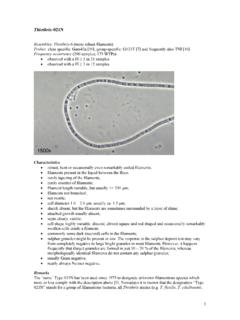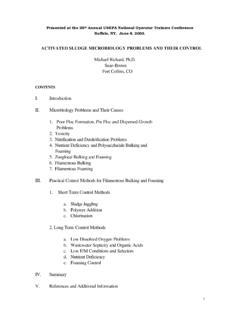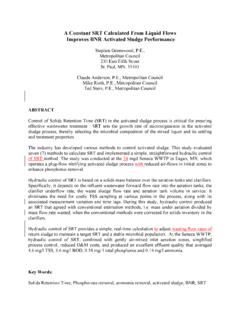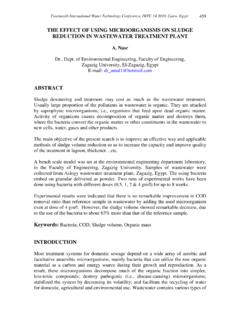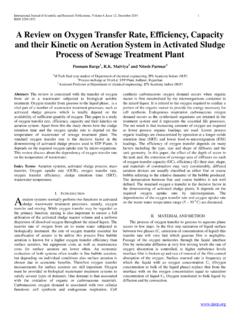Transcription of FILAMENTIOUS BACTERIA IDENTIFICATION & …
1 FILAMENTIOUS BACTERIA IDENTIFICATION & process . control . A Simple Approach INTRODUCTION. Under normal conditions in activated sludge , BACTERIA occur singly, in small chains or clumps. Under adverse conditions however, BACTERIA that grow in filaments begin to form longer chains called filamentous BACTERIA or filaments . Filaments can dominate in the wastewater treatment system under a variety of conditions. These conditions are usually less favorable for the floc-forming BACTERIA so, this allows the filaments to gain an advantage. The presence of some filaments in the activated sludge is advantageous. They aid in settling by providing a back-bone for floc-forming BACTERIA to attach to. However, when filaments begin to grow in excess amounts, extending from the floc into the bulk fluid, they can interfere with settling and my cause foaming upon aeration. Different types of filaments dominate under different conditions. Identifying which filaments are dominating in the system will help the operator to understand the condition in the treatment system so that corrective changes can be made.
2 Microscopic evaluations to identify filamentous BACTERIA can be complicated and time consuming. This lesson will provide a simple approach to identifying filaments in the activated sludge as well as provide suggestions for corrections. Microscope Requirements Objectives The objectives on the microscope are used to magnify the specimen. In order to begin observing filaments under the microscope, it would be helpful to have a 10X. (magnifies the specimen 100 times) or 20X (magnifies the specimen 200 times) objective along with a 40X (400 times) and an oil immersion objective. The oil immersion objective must be used with a drop of immersion oil and magnifies the specimen 1000. times. Phase contrast Microscope The normal, compound microscope is equipped with a condenser that focuses the light beam onto the specimen. This produces a brightfield illumination. Most microorganisms are relatively clear and since the fluid is also clear, under brightfield illumination it is difficult to see distinct cell structures.
3 Phase contrast illumination uses a special condenser, which slows down the light as it enters the denser parts of the microorganisms. This allows certain structures to stand out from other less dense parts of the cell and from the surrounding fluid. This technique allows you to observe the organisms while they are alive. Cell shape and structure are more visible than with brightfield illumination. Phase contrast is more suitable for observing live organisms. This lens translates small differences into clearly observable differences. Phase contrast is especially useful when observing filamentous BACTERIA . There are a variety of characteristics that are unique to these BACTERIA and are important when trying to identify them. These characteristics can be clearly seen using the phase contrast condenser. Slide Preparation & Staining In order to observe the unique characteristics of the different types of filamentous BACTERIA , it is important to use a wet mount.
4 Using a wet mount, a drop of the sample is placed on a clean dry slide and is covered with a cover slip. This allows the observer to view the microorganisms live in their environment. With a live sample, measurements can be taken and cell shape and size can be accurately determined. Smears on the other hand, are not useful for determining cell size and shape. To make a smear, a drop of sample is placed on a clean slide and is smeared across the slide and allowed to air dry. The drying process distorts the size and shape of many of the cells. Smears are useful for staining only and are particularly useful when identifying filamentous BACTERIA . The most commonly used staining techniques are simple staining and differential staining. The simple stain uses only one stain, which dyes all the microorganisms, the same color. This stain is used to simply make the microorganism more visible for observation. Differential staining uses more than one dye which reacts differently with different types of microorganisms.
5 It helps to distinguish one type of microorganism from another. The differential staining technique is the one more often used in the wastewater treatment lab. There are several stains that are often used when identifying filamentous BACTERIA (See Appendix A for Staining Procedures). The most common are the Gram Stain and the Neisser Stain. Gram Stain The Gram stain separates BACTERIA into two categories: gram (+), those that retain the purple color of the crystal violet and gram (-), those that do not Gram (+) Gram (-). retain the crystal violet Nocardia sp. Type 1701. when decolorized but is counter stained pink. The procedure uses four solutions; a crystal violet solution, an iodine solution, alcohol for decoloration and a counter stain safranin (Detailed staining procedures are listed in Appendix A). Only a few filaments stain gram (+), most of the filamentous BACTERIA found in activated sludge are gram (-). There are a few however, that stain gram-variable.
6 This means that a portion of the filament stains gram (+) while another portion of the same Gram variable filament stains gram (-). Type 0041. Neisser Stain The Neisser stain also separates the BACTERIA into two categories. It distinguishes those BACTERIA that have the ability to accumulate polyphosphate. Those that accumulate Neisser (+). Nostocoida limicola polyphosphate are Neisser (+) and stain bluish purple. Neisser (-) BACTERIA stain brown. Some BACTERIA however do store granules that contain polyphosphate. In this case, Neisser (+) granules can be seen inside of the filament (Details staining procedures are listed in Appendix A). As with the Gram stain, only a few filaments stain Neisser (+). The majority of the filaments in wastewater stain Neisser (-). There are a few however, that contain Neisser (+) polyphosphate granules. TYPICAL OBSERVATION OF. FILAMENTOUS BACTERIA . The typical process for identifying Neisser (+) granules filamentous BACTERIA can be time consuming and difficult.
7 Most wastewater treatment plant operators are charged with the responsibility of operating, maintaining, and cleaning the plant, along with performing all of the laboratory tests for process control and discharge permit compliance. Many are also responsible for drinking water, city lawn mowing and snow removal. It is not fair to add the typical, tedious task of identifying filamentous BACTERIA to their already overloaded work schedule. In the past many keys or charts have been developed to help the operator to identify filamentous BACTERIA . In order to use the charts however, the operator must first gather information about the filament and then using this information, follow the chart to identify the probable filament. The time consuming part is gathering the information. To use the charts the operator would be required to measure the length and width of the filament, the length and width of the individual cells, record the shape, along with many other characteristics.
8 This course is an attempt to simplify the process , so that the operator or lab personnel with a little time to spare can identify these filaments with relative ease. Before discussing this simple approach, let's learn a little more about the different characteristics of filamentous BACTERIA . Filament Structure In the activated sludge treatment system, BACTERIA may occur singly, or in small chains or clumps. Shifts in the activated sludge environment such as changes in pH, dissolved oxygen, nutrients etc. will often cause a change in the behavior of the BACTERIA . In stead of single cells, small chains or clumps, the BACTERIA will begin to form longer chains which develop into filamentous BACTERIA . Round BACTERIA will form a chain with other round BACTERIA , square with square, rectangle with rectangle etc. I jokingly call these chain gangs . These longer chains or filaments allow the BACTERIA to compete better in the changing environment.
9 Filament Shape & Size Filament shape is one of Straight the characteristics often used to help identify filamentous BACTERIA . Some filaments are Smoothly smoothly curved, some are Irregular Curved straight and others are simply irregularly shaped. Filaments can range in size from to 5 m in width and from 5 to > 500 m in length. Cell Shape & Size The individual cells that make up the filament can be either bacillus shaped which includes square, rectangle or barrel-shaped cells or coccus shaped which includes round, oval, or rod-shaped cells. There is also a wide variation in the size of the individual cells that make up the different filaments. Another characteristic that is often listed on many filament IDENTIFICATION charts is the presence of visible cell septa . In most cases filaments are made up of individual cells stacked together (a few filaments are made up of one long cell). Cell septa can be defined as the visible line separating each individual cell.
10 In some filaments the cell septa can be clearly seen while in others the septa is not visible at all. These same charts will also ask if the cell septa are indenting . This can be observed if there is an indentation at the septa as noted in the figure. Other Characteristics There are several other characteristics that when observed will help in the process of Cell Septa identifying the different types of filamentous BACTERIA . No Visible The presence or absence of a sheath Cell Septa The presence of epiphyte (attached growth) Indenting True or false branching Cell Septa Motility Cell septa with Cell septa with Cell septa not no indentation indentation clearly seen The Presence or Absence of a Sheath Some filaments are made up of cells stacked together and contained within a tight fitting sheath, much like a clear soda straw with cells stacked inside. Not all filaments have a sheath. Those that do may vary in size and shape and may have other characteristics that are not Individual cells within a sheath similar at all.


